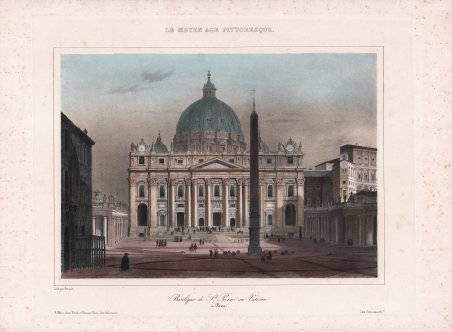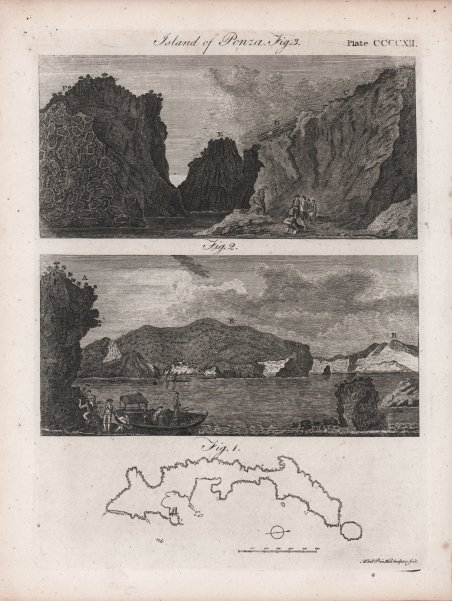Coppia di vedute e carta geografica dell’isola di Ponza, stampate su un foglio tratto dalla ' Encyclopaedia Britannica Or a Dictionary of Arts, Sciences and Miscellaneous Litterature ' · Volume 15, n. 1, stampato ad Edimburgo nel 1810. Le vedute sono riprese da quelle pubblicate nel libro "Some particulars of the present state of Mount Vesuvius; with the account of a journey into the province of Abruzzo, and a voyage to the Isle of Ponza", di Sir William Hamilton, Philosophical Transactions of the Royal Society, vol.76 (1786), tratte da disegni di Francesco Progenie realizzati direttamente dalla feluca di Sir William Hamilton (1731-1803). Raffigurano Hamilton che dirige l'artista e operai con martelli che prelevano campioni di roccia (in basso a sinistra). Una bellissima descrizione dell’isola ci viene direttamente dal testo dell’Encyclopædia Britannica: “PONZA, or PONTIA, is a small island of the Tuscan Sea, well known to be the place to which many illustrious Romans were formerly banished. It is situated on the coast of Italy near Terracina, and in the neighbourhood of other small islands or rocks named Palmarole, Zannons, &c. between the island of Ventotienne and Monte Circello. All these islands were visited by Sir William Hamilton in the year 1785; and an account of his journey is given in a letter to Sir J. Banks, which appeared in the Phil Trand. vol. Ixxvi. p. 365. Sir William arrived at Ponza on the 20th August; and, according to his account, it lies about go 30 miles mile from Ventotienne. On the aust he went round it in a boat. Its length is about five miles, but its breadth is nowhere above half a mile, and in some places not more than 500 sect. It is surrounded by a multitude of detached rocks, some of them very high, and molt of of them composed of a compact lava. There are many irregularly formed basaltea, but none in large columns. In some places they have a reddish tinge from iron ochre, are very small, and irregularly laid over one another. Some stand perpendicularly, others obliquely, and some lie horizontally. The rocks themselves in which these masses are found are lava of the fame nature with the basaltes. At first fight they appear like the ruins of ancient Roman brick or tyle buildings. One rock is composed of large spherical basalts, and in other places our author found the lava inclined to take the like Spherical form, though on a much smaller scale, some of the former basalts being near two feet in diameter. All these rocks, in our author's opinion, have been detached by the sea from this island, which is entirely composed of volcanic matter, lavas, and tufas of various quidities and colours, as green, yellow, black, and white. Some of these matters are more compact in their texture than others; and in some parts great tracts seem to have undergone similar operations, which flill fuhlitt at a spot called the Pisciareli, on the outside of the Solfatara, near Puzzole, and where a hot sulphurcous vitriolic acid vapour converts all which it penetrates, whether lavas, tufas, volcanic alhes, or pumice-tones, into a pure clay, mofily white, or with a tint of red, blue, green, or yellow. In one part of this island there is a fort of tufa remarkably good for the purpose of building. It is as hard as Bath-stone, and nearly of the fame colour, with- out any mixture of lava or pumice-stone, which usually abound in the tufas of Naples, Buia, and Puzzoli. 'The island of Palmarole which is about four miles from Ponza, is not much more than a mile in circumference. It is composed of the fame volcanie matter, and probably was once a part of Ponza; and in our author's opinion it looks as if the island of Zannone, which lies about the fame distance from Ponza, was once likewise a part of the fame; for many rocks of lava rife above water in a line betwist the two lait-mentioned islands, and the water there is much more thallow than in the gulf of Terracina. Zannone is much larger and higher than Pa. Pair of views and map of the island of Ponza, printed on a sheet from the Encyclopaedia Britannica Or a Dictionary of Arts, Sciences and Miscellaneous Litterature - Volume 15, No. 1, printed in Edinburgh in 1810. The views are taken from those published in the book "Some particulars of the present state of Mount Vesuvius; with the account of a journey into the province of Abruzzo, and a voyage to the Isle of Ponza," by Sir William Hamilton, Philosophical Transactions of the Royal Society, vol.76 (1786), taken from drawings by Francesco Progenie drawn directly from the felucca of Sir William Hamilton (1731-1803). They depict Hamilton directing the artist and workers with hammers taking rock samples (lower left). A beautiful description of the island comes to us directly from the text of the Encyclopædia Britannica: “PONZA, or PONTIA, is a small island of the Tuscan Sea, well known to be the place to which many illustrious Romans were formerly banished. It is situated on the coast of Italy near Terracina, and in the neighbourhood of other small islands or rocks named Palmarole, Zannons, &c. between the island of Ventotienne and Monte Circello. All these islands were visited by Sir William Hamilton in the year 1785; and an account of his journey is given in a letter to Sir J. Banks, which appeared in the Phil Trand. vol. Ixxvi. p. 365. Sir William arrived at Ponza on the 20th August; and, according to his account, it lies about go 30 miles mile from Ventotienne. On the aust he went round it in a boat. Its length is about five miles, but its breadth is nowhere above half a mile, and in some places not more than 500 sect. It is surrounded by a multitude of detached rocks, some of them very high, and molt of of them composed of a compact lava. There are many irregularly formed basaltea, but none in large columns. In some places they have a reddish tinge from iron ochre, are very small, and irregularly laid over one another. Some stand perpendicularly, others obliquely, and some lie horizontally. The rocks themselves in which these masses are found are lava of the fame nature with the basaltes. At first fight they appear like the ruins of ancient Roman brick or tyle buildings. One rock is composed of large spherical basalts, and in other places our author found the lava inclined to take the like Spherical form, though on a much smaller scale, some of the former basalts being near two feet in diameter. All these rocks, in our author's opinion, have been detached by the sea from this island, which is entirely composed of volcanic matter, lavas, and tufas of various quidities and colours, as green, yellow, black, and white. Some of these matters are more compact in their texture than others; and in some parts great tracts seem to have undergone similar operations, which flill fuhlitt at a spot called the Pisciareli, on the outside of the Solfatara, near Puzzole, and where a hot sulphurcous vitriolic acid vapour converts all which it penetrates, whether lavas, tufas, volcanic alhes, or pumice-tones, into a pure clay, mofily white, or with a tint of red, blue, green, or yellow. In one part of this island there is a fort of tufa remarkably good for the purpose of building. It is as hard as Bath-stone, and nearly of the fame colour, with- out any mixture of lava or pumice-stone, which usually abound in the tufas of Naples, Buia, and Puzzoli. 'The island of Palmarole which is about four miles from Ponza, is not much more than a mile in circumference. It is composed of the fame volcanie matter, and probably was once a part of Ponza; and in our author's opinion it looks as if the island of Zannone, which lies about the fame distance from Ponza, was once likewise a part of the fame; for many rocks of lava rife above water in a line betwist the two lait-mentioned islands, and the water there is much more thallow than in the gulf of Terracina. Zannone is much larger and higher than Palmarole; and that half of it next the continen. Cfr.


Scopri come utilizzare
Scopri come utilizzare

